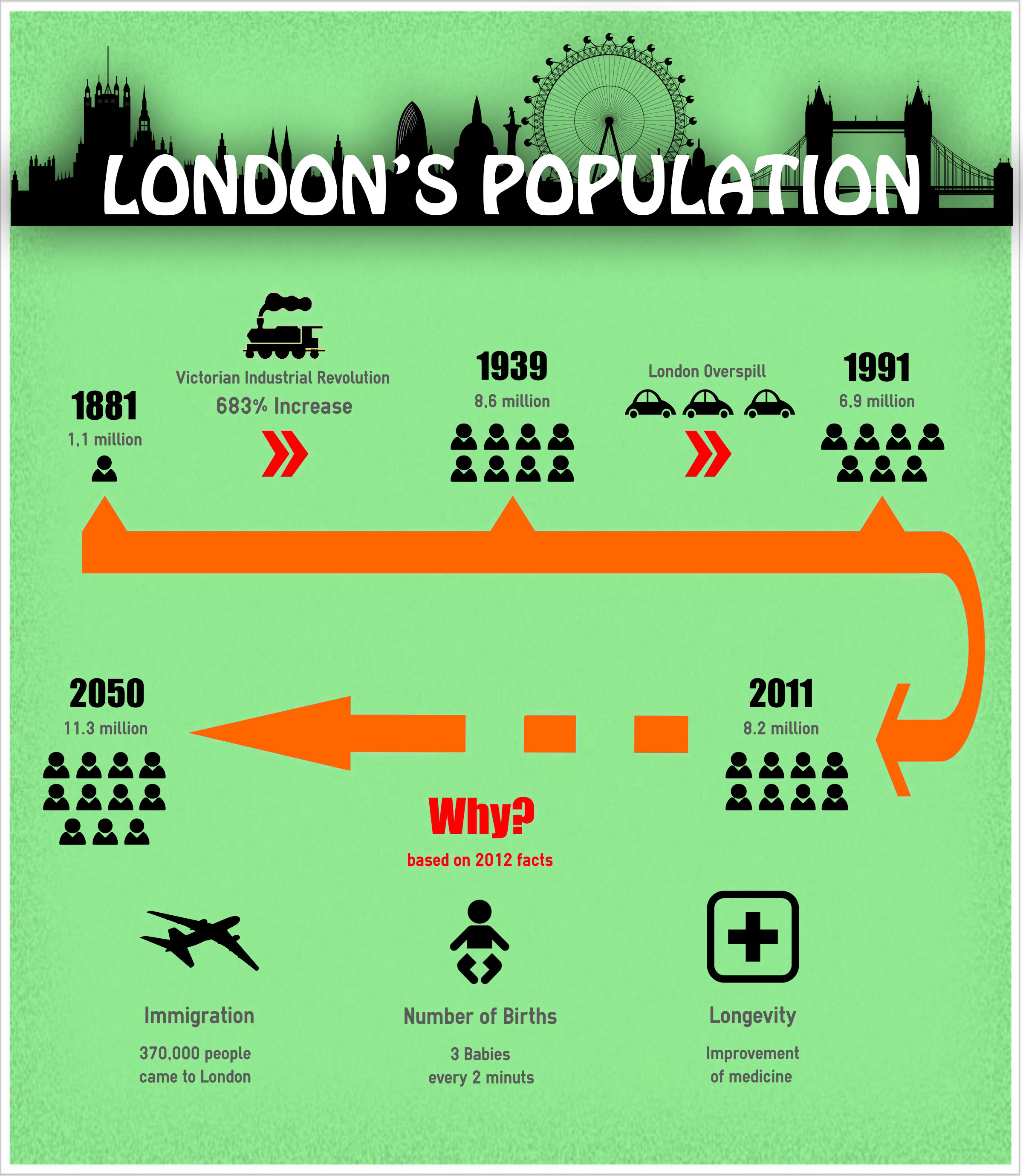Understanding London’s Growing Population
Since 1801, London’s population has grown from 1.1 million (m) to 8.2m in 2011. Over the next 39 years (to 2050) it is expected to rise steeply to over 11.3m people. This is predicted to put a huge strain on the current London infrastructure which has been in place since the peak population of 8.6m in 1939.
Between 1801 and 1939, the huge Victorian industrial revolution saw a 683% increase in the population of London. This came at a time when agriculture was in decline and industry was booming, meaning that more and more people were required to work in the factories in London. The Second World War in 1939, however, then set into motion a series of events which saw people leaving London in droves.
London was the primary target for enemy bombers, leading it to become an extremely unsafe place. Many were evacuated and others decided to leave for perceived safety of the country. Those who did stay, however, were poorly rewarded, with the London shipyards (the main industry in the capital) falling into disuse after the war. Despite an increase in immigration (largely from Southern Asia), both the immigrants and the industrial jobs moved to the north of England, leaving the population of London waning.
During the 1950’s and 60’s, the ‘London Overspill’ initiative moved the ‘slums’ of London to other cities, further decreasing the population.
However, since the decline in British industry in the 1980’s, the jobs have, once again, moved South. According to Migration Watch (an immigration lobby group) over ⅔ of the immigrants arriving in the UK since the mid-nineties have come to London. This has caused the London population to grow once more with nearly 2m people arriving since the 6.9m low of 1991.
This most recent surge in population – backed by significant foreign investment in London property – has seen the London economy boom, even during the 2008 economic recession.
While the rise in London population, coupled with the dwindling ‘White British’ population (44% in the 2011 census) has largely been linked to increased immigration in London, the facts don’t appear to corroborate that statement.
In the year to July, 2012, the number of people who moved into London (from other parts of the UK and from abroad) was 370,000. The number who left London was 360,000. It can be seen that immigration is not the only reason for the increase in London population. The greater reason seems to be the number of births in the capital.
The higher birth-rates of foreign women and the increased fertility rates of British women, meant that from January to July 2012 over 134,000 babies were born, adding over 90,000 to the population of London. So while one may drive the other, it is newborn’s, not immigrants who are driving the population increase of London.
The population of London, however, is expected to rise more quickly now than at any other time in their history. This is down to two significant things. Firstly, as previously alluded to, the birth rate of mothers in London have risen significantly with, in the UK in 2011-12, 3 babies born every two minutes and over 250,000 more births than deaths.
The second significant reason is the increasing benefits to longevity of improved medicine and greater health among the older generation. The average national age is expected to rise from 39.7 years to 42.8 years by mid-2037. That will lead to an increase in the proportion of the population aged over 75 from 7.8% to 13% in the same time frame.
This, while perhaps not a bad thing, could potentially have huge knock on effects. With huge bolstering of the two polar ends of the London demographic, more schools and housing will have to be provided to young children and families while extra care homes will have to be built, and better facilities will have to be added to cater to the increasing older generation.
The projections seem to suggest that the boroughs of London with the largest population increase will be those in Outer London. From 2011 to 2041, the population in Outer London is expected to increase by 37% to over 6.7m. In Inner London over the same period the population is expected to rise just 11% to 3.6m.
Most boroughs in London are predicted to have their populations grow significantly. The only boroughs seemingly safe from the huge population grown are those in the affluent areas in South West London (specifically, Kensington & Chelsea, Richmond, Kingston-Upon-Thames and Wandsworth – but expanding to include Sutton). The populations of these areas is expected to increase by 15% from 2011-2041 against the London wide prediction of 26%. This has largely been put down to the high house prices in these areas becoming extremely prohibitive for many.
The population of London has tended to fluctuate over the last 80 years, but has not yet had to change an infrastructure developed in 1939 for the London peak population of 8.6m – with forecasts predicting it will skyrocket over the next few decades the infrastructure of the city is going to be forced to change to adapt with changing demographics and increase strain on all sectors of London.
